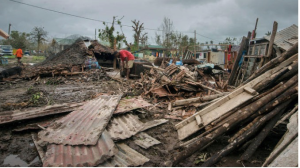The strong cyclone that swept through the Pacific island nation of Vanuatu yesterday occurred at the same time that government representatives, including the President of Vanuatu and the head of Vanuatu’s National Disaster Management Office, were meeting at a UN conference in Japan to devise a new global plan to reduce the risk of disasters such as this one. According to media reports, Vanuatu has prepared for cyclones but not for one of this intensity. There are reports that even the National Disaster Management Office’s emergency communications systems have been disrupted by the storm. In a statement today, Oxfam Australia said that up to 90% of the housing in the capital of Port Vila had reportedly been seriously damaged. An Oxfam official said that this “is likely to be one of the worst disasters ever seen in the Pacific.”
Although communications reportedly have been reestablished in the capital city, the extent of the devastation in Vanuatu, a country of 267,000 people spread out across 65 low-lying islands, is not yet clear, according to media reports. The convergence of the cyclone and the UN conference on disaster risk reduction in the same weekend seems to underscore both a growing global reality of more frequent extreme weather events and increasing global recognition of the need for formal mechanisms to help societies prepare for the unexpected–whether from extreme weather events, disease outbreaks, or conflicts.

Illustration: Conte crayon by Black Elephant Blog author modeled upon “Rider and Fallen Foe” by Titian
As we have seen when regions undergo recurrent stresses and shocks, the health and well-being (or security) of any people’s “homeland” must unavoidably concern us all. It turns out that resilience is a local issue with global consequences–with effects that eventually come home to roost. Ignoring what is happening on the other side of the world is not a viable option. Taking a larger view of the challenges is necessary–and may help with acquiring a larger perspective on possible responses. We have much material and experience, as well as creativity, imagination, and resourcefulness to draw into the viewfinders. The UN Secretary General has similarly observed that the rebuilding effort of Sendai, Japan, four years after it was destroyed by an earthquake and tsunami, is a reminder that “we must turn all of the painful lessons of disasters into new policies for a better future.”
What the officials at the UN meeting in Sendai, Japan have concluded is that the Ebola outbreak in West Africa, powerful storms in the Asia-Pacific region and ongoing conflicts around the world are compelling reminders that “health and stronger health system capacities must be central to the new framework for managing disaster risk,” as reported by U.N. health agency officials today. Public health is interconnected with, and a foundational requirement for, the ability to withstand disasters of all kinds. In whatever language it is conveyed, this message is relevant to all people of the world… Threats and unwelcome surprises come in many forms; traditional means of defense, including walls and barricades, may no longer suffice. Different thinking and relationships may be needed.

Illustration: Graphite on paper by Black Elephant Blog author after “Group of Figures” sketch by Luca Cambiaso circa 1560s
As we have just completed a session on “Resilience” in the class I am co-teaching, for which we relied on some excellent materials from varied sources, my next blog post will assemble some notes in one place regarding some of the latest thinking and practices related to “resilience,” including what it is, and some of its characteristics. How is resilience different from other sorts of preparedness and who needs to be involved? How do we know when we are “resilient” enough in an age of high-impact, unknown probability risks? Perhaps these notes–which draw from, among other sources, the helpful new book by Judith Rodin, President of the Rockefeller Foundation, The Resilience Dividend–will be as useful to someone else as they have been to me recently! As our class continues to explore: Understanding more about resilience is important not only for island nations but for the health of nations generally.

